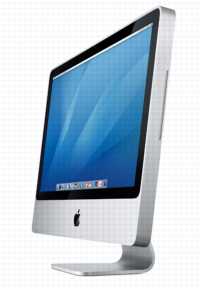Does the glossy screen of the new iMac suck?

There's a lot of buzz online about the glossy LCD screen on the new generation of iMacs, called the Aluminum iMac. Some people love it and some hate it.
However, its new glossy screen may have a deeper meaning in Apple's positioning for consumer, business and professional systems.
Apple used to offers customers a choice between glossy and matte screens on its MacBook Pro notebooks previous white iMacs. When I bought one, I chose the matte screen. Why? Because a matte surface is better for evaluating color in images. [Updated Monday, August 27, 2007. Yikes. I wrote that Apple once gave customers a choice of glossy and matte screens for the iMac and that was wrong, wrong, wrong. Thanks to all the people who pointed this out. I was thinking of the MacBook Pro that I bought around the same time.]

I pinged Karl Lang, a color scientist, product developer and a former colleague of mine at Miro Displays, a Silicon Valley monitor and color calibration business back in the dotcom boom days. The company bought the Radius brand and developed the ColorMatch PressView XL evaluation disply system for professional graphics workflows.
He expressed some alarm over some of the online discussion, pointing to threads that dismissed the effect of reflection. One anonymous Aug. 14 reader comment on Macintouch rubbed him the wrong way:
A lot of people seem to be missing the point on the current debate over glossy screens. There is a reason why black and white photos for reproduction are always gloss not matte: gloss surfaces reflect light back at an angle that matches the source - light a gloss surface that is parallel to you at 45 degrees and you will see no reflections. Matte surfaces diffuse the light which means you get some glare at every angle and you will never get pure blacks. With a gloss screen, unlike a matte screen, it is possible to avoid reflections altogether. The notion that "pros won't use gloss screens" is spurious.
Lang said that if our computing environment was all black and illumination arrived at our screen from only one source of parallel rays, this argument might make sense. However, computing in the real world is a different experience.
"Light is reflected off all objects around us. A matte surface diffuses this off(x) illumination and creates a relatively even background.
"A glossy screen reflects a sharp picture of the global illumination model — what you see is the room, the ceiling, your yellow t-shirt, etc. In the view areas where the picture is black, you will have a darker black. But overall the image will be fighting with the picture of your surroundings," Lang said.
I remember that the PressView XL color evaluation system that we sold in the days came with a hood to cut out some of the ambient light. It also came with the "stealth coat," which was a ninja black happi coat that the user could wear to minimize color contamination reflected from their clothing.
Now, someone like my wife, who uses an Intel iMac, really doesn't do any "professional-level" color evaluation. She manages lists, processes text documents and surfs the Web for bargains. And the images on the Web mostly aren't from a color-calibrated workflow.
From Apple's viewpoint, most of the target market for the iMac doesn't care whether the screen is glossy or matte. Then again, some customers will prefer the glossy screen.
"There's a percentage of a market segment that wants a glossy screen and thinks a glossy screen is cool, no doubt that that's the case," Lang said, pointing to the gamer demographic." They usually can be found in dark rooms — there [the glossy screen] works great."
I can imagine that the glossy screen is also easier to clean and that would appeal to education market customers.
In my column about the iMac launch I wondered about what professional means now to Apple since the iMac and iWork '08 appear aimed at small business and departmental users.
For the desktop, the "pro" designation obviously means a multiprocessor workstation. This makes sense for Apple’s base doing professional content creation tasks or crunching visualizations for sci-tech apps.
Lang offered that Apple's move to glossy screens could be about this professional-consumer positioning. He said Apple has been losing desktop sales to iMacs parts of the professional imaging segment. And there's a lot more money in a desktop than in an iMac.
"Apple is trying to discourage iMac sales by pros. With the move to Intel [processors], Apple lost a lot of speed and performance issues between the desktop and iMac. The iMac did almost everything. I mean, why isn't that 24-inch [iMac] a layout machine? It is. So the only way to discourage a designer is to put a shiny screen on it," Lang suggested.
So, there's really nothing wrong with a shiny screen on an iMac. It's okay to love that shiny screen.
But if color evaluation is important to you, and you want a Mac, then you will have to step up to a pro machine. Or live with the shine.